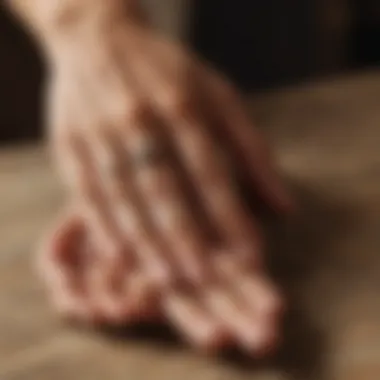Exploring Indian Palmistry: Insights into Ancient Art


Intro
Indian palmistry, or hast Jyotish, presents a fascinating insight into the ancient practice of reading palms for personal guidance. This art form, rooted in deep historical traditions, offers a comprehensive understanding of how the lines, mounts, and shapes on an individual’s palm can reveal important aspects of their personality, health, and future. It moves beyond simple divination, serving as a practical tool for self-reflection and growth.
Understanding the nuances of palmistry requires patience and study. Each line has specific meanings and varies from person to person. For instance, the Heart Line speaks to emotional insights while the Head Line reflects intellectual capabilities. Additionally, the mounts found at the base of the fingers indicate personal characteristics and motivational factors.
Palmistry is not just about predictions; it also emphasizes self-awareness and personal development. Engaging with this ancient practice can empower individuals in their life journey, shedding light on paths they may choose to embrace or avoid.
This article will delve into the key elements of Indian palmistry, providing a clear guide for both enthusiasts and those exploring this ancient art for the first time. We will explore the historical context, the methodology of reading palms, and the implications of various palm features.
To begin, we will discuss zodiac profiles, offering insights into how these astrological signs connect with palmistry, thus enriching the reader's overall understanding.
Intro to Indian Palmistry
Indian palmistry, also referred to as hast Jyotish, serves as an essential aspect of the broader field of astrology. This ancient practice is not just about predicting the future; it provides profound insights into personality traits, health, and potential life pathways. Understanding Indian palmistry allows individuals to connect with their inner selves while deciphering the messages etched in their palms.
In this section, we explore its definition and historical context, laying the groundwork for recognizing the benefits of palm reading.
Definition and Overview
Indian palmistry is defined as a method of divination that interprets the lines, mounts, and shapes of the palm. It seeks to understand the connections between physical attributes of the hands and psychological or spiritual dimensions of an individual. This practice highlights specific features such as the heart line, head line, life line, and various mounts, all of which contribute to a comprehensive personality profile.
The significance of the practice lies in its ability to empower individuals. By gaining insights from their palms, they can foster greater self-awareness and make informed decisions about their lives. It serves not only as a tool for personal development but also as a lens through which one may view relational dynamics and spiritual growth.
Historical Context of Palmistry
The roots of Indian palmistry can be traced back thousands of years, intertwining with the traditions of various cultures. Historical texts, such as the Shastras, reference palmistry, underscoring its importance in Indian culture. The practice flourished during ancient times, believed to be a gift from divine sources, guiding sages and scholars alike in their spiritual quests.
Over the centuries, Indian palmistry has integrated influences from many traditions such as Chinese and Western astrology. Notably, during the early medieval period, palmistry was viewed as a merging of science and art, where the physical attributes of hands were studied alongside psychological principles. This historical context enriches the understanding of modern palmistry, affirming its continued relevance and adaptability.
The insights of palmistry are not merely fortune telling; they offer a complex reflection of an individual’s journey through life.
Core Components of Indian Palmistry
Understanding the core components of Indian palmistry is essential for anyone looking to grasp the nuances of this ancient art. These components provide a framework for interpreting the intricacies of the palm, offering insights into personality traits, emotional well-being, and potential life paths. The lines, mounts, and overall hand shapes all play a crucial role in shaping our interpretations.
Major Lines
Heart Line
The Heart Line is one of the most significant lines in palmistry as it reveals insights into an individual’s emotional state and romantic inclinations. Typically located at the top of the palm, this line represents matters of the heart, showcasing a person’s capacity for love and relationships. The key characteristic of the Heart Line is its length and curvature; a longer, more curved line suggests a warm and nurturing personality, while a straighter line might indicate a more reserved emotional nature.
Its unique feature lies in its ability to indicate not just romantic tendencies but also emotional resilience. This makes it a beneficial element to analyze for those seeking to understand their emotional landscape. However, interpretations can vary by cultural context, which adds a layer of complexity.
Head Line
The Head Line reflects intellectual capabilities and decision-making style. This line often runs parallel to the Heart Line, indicating the balance between reasoning and emotion. A clear and deep Head Line suggests strong analytical skills and clarity of thought, reinforcing its importance in this article.
This line’s unique aspect is that it can reveal one's thought process and orientation toward life; someone with a wavy line might be more spontaneous, while a straight line indicates a more methodical approach. This variability provides rich insights into the individual’s psyche.


Life Line
Contrary to popular belief, the Life Line does not solely reflect the length of life but rather indicates vitality and the quality of life. It traces a curve around the base of the thumb, connecting with the area of the wrist. A robust and deep Life Line suggests a strong constitution and a zest for life, while breaks or chains might symbolize periods of struggle or health issues.
Understanding the Life Line is crucial for those looking to explore personal health and longevity. Its unique characteristic is that it offers perspectives not only on physical life but also on overall life experiences and significant turning points.
Fate Line
The Fate Line, although not present on everyone’s palm, is pivotal when analyzing life’s path and destiny. This line runs vertically through the center of the palm, highlighting life choices, career trajectories, and outer influences. Observing its clarity or brokenness can indicate how much control a person has over their life unfolding.
The primary characteristic of the Fate Line is its connection to external circumstances, showing how life events impact personal development. For people interested in career success and life direction, this line offers valuable insights.
Minor Lines
Sun Line
The Sun Line represents fame, creativity, and one's relationship with the public sphere. Found parallel to the Fate Line, a well-defined Sun Line indicates a person likely to achieve recognition for their talents. Its key characteristic is its capacity to showcase artistic and creative potential, making it valuable in personal evaluation.
The unique aspect of the Sun Line is that it highlights not just public recognition but also self-expression. However, a faint or absent line does not imply a lack of ability; it may instead reflect a more inward-focused approach.
Mercury Line
The Mercury Line signifies communication skills and intellect. This line’s characteristically shorter curve reflects the importance of verbal and written expression. A prominent Mercury Line indicates strong persuasive abilities and quick wit, making it a beneficial element for those engaged in creative or analytical professions.
This line also emphasizes the necessity of clear communication, suggesting its importance in workshops and team settings. Its main advantage lies in how it shapes social interactions.
Marriage Lines
These lines are crucial for understanding aspects of romantic partnerships. Usually located on the outer edge of the palm, they indicate significant relationships rather than the total number of marriages or partnerships one might have.
The length and clarity of Marriage Lines provide insight into the nature and strength of emotional bonds. A strong line indicates deep emotional connections, while shorter ones may suggest brief relationships. This analysis highlights the importance of emotional compatibility and connection.
Mounts of the Palm
Mount of Venus
The Mount of Venus is associated with love, sensuality, and compassion. Positioned beneath the index finger, it signifies a person’s romantic nature. A pronounced Mount indicates strong affection and social connections, benefitting any analysis focusing on interpersonal relationships.
This mount is unique in its ability to showcase warmth and relational aspects of personalities. However, excess prominence can imply overindulgence or dependency in relationships.
Mount of Jupiter
Representing ambition and leadership, the Mount of Jupiter lies under the index finger. A strong Mount signifies confidence and a drive for achievement, underpinning discussions about career aspirations.
This mount is also a reflection of a person’s ethical standards and ideals, making it a crucial consideration for personal evaluations.
Mount of Saturn
The Mount of Saturn links to responsibility and practicality. Found underneath the middle finger, its presence indicates a serious nature and a propensity for caution in financial matters. Individuals with a high Mount of Saturn often display wisdom and durability.


This aspect is beneficial for people looking to explore their sense of duty and measured approaches to life challenges.
Mount of Apollo
The Mount of Apollo relates to creativity and self-expression. Situated under the ring finger, a well-developed mount signifies artistic talents and a love for beauty. This is especially important for those analyzing their creative aspirations.
The uniqueness of the Mount of Apollo lies in its association with personal fulfillment through art, culture, and performance, making it valuable for aspiring artists.
Mount of Mercury
Positioned under the little finger, the Mount of Mercury focuses on communication skills and intellect. An elevated Mercury mount illustrates an individual’s skillfulness in social situations and adaptability. This aspect is noteworthy for anyone in fields needing effective dialogue.
In summary, the core components of Indian palmistry provide a comprehensive understanding for practitioners and enthusiasts alike. Each line and mount enriches the narrative of an individual's life journey. Carefully studying these components leads to deeper self-awareness and informed personal development.
Understanding Hand Shapes
Understanding hand shapes is vital in the study of Indian palmistry. The form of a person's hand can reveal essential insights about his or her character traits, tendencies, and overall life approach. Each hand shape correlates with the four classical elements: Earth, Air, Water, and Fire. Recognizing these shapes can enhance the practice of palm reading. By evaluating the fundamental shape characteristics, one can delve deeper into personal strengths and potential challenges.
Elemental Hand Shapes
Earth Hands
Earth hands are characterized by a square palm and short fingers. This shape signifies practicality, reliability, and a strong connection to nature. Individuals with earth hands tend to be grounded and realistic. Their key characteristic is a strong focus on material and physical aspects of life, which often leads them to excel in tasks requiring attention to detail.
The unique feature of earth hands is their sturdy feel; they often indicate a person who is methodical, patient, and logical. In palmistry, earth hands are seen as a beneficial attribute for individuals seeking a stable and secure life. However, caution is advised, as overly earthy tendencies may lead to rigidity or resistance to change.
Air Hands
Air hands are identified by a rectangular palm and long fingers. This shape reflects adaptability, intellect, and strong communication skills. Its individuals are usually thinkers, often thriving in dynamic environments. The key characteristic of air hands is their sociability; they excel in situations involving interaction and exchanges of ideas.
A notable feature of air hands is their agility in thought and expression. This gives them a distinct advantage in any setting that values innovative ideas. However, these strengths may come with the downside of being perceived as detached or inconsistent, requiring balancing with attentive emotional grounding.
Water Hands
Water hands have a rectangular form with a palm that is wider than it is tall. This shape indicates emotional depth, intuition, and creativity. Typically, people with water hands are sensitive and in tune with their feelings and those of others. Their key characteristic lies in emotional intelligence, which allows them to navigate complex social situations with ease.
A unique aspect of water hands is their expressive capability. This expressiveness can be a great advantage, as it enables deep connections with others. However, it can also lead to vulnerability, as they can be prone to mood swings or emotional overwhelm.
Fire Hands
Fire hands exhibit a square palm and long fingers, embodying energy, passion, and enthusiasm. Individuals displaying this hand shape are often dynamic and assertive leaders. The key characteristic of fire hands is their drive; these individuals are typically fearless and ready to take risks.
A unique feature of fire hands is their zest for life. This innate enthusiasm offers them significant advantages in leadership roles or creative pursuits. However, people with fire hands must be cautious of impulsiveness or burn-out that can arise from their high energy levels.
Interpreting Shape Characteristics
By examining the various elemental hand shapes, practitioners can draw nuanced conclusions about the individual’s personality and potential life path. Each shape holds valuable information that can be key in mastering the art of palmistry. Unlocking these insights may lead to increased self-awareness and personal growth.
The Role of Palmistry in Personal Development


Palmistry serves as more than a simple curiosity; it acts as a pragmatic tool for personal development. Understanding palmistry can inspire new perspectives, enhance self-awareness, and refine interpersonal relationships. The subtle nuances of palm readings allow individuals to embark on a journey of self-discovery and growth. The utility of this ancient practice lies in its ability to reflect one's personality traits, challenges, and potential future paths. This section explores its significant role in two main areas: self-reflection and relationships.
Self-Reflection through Palm Reading
Self-reflection is a critical component of personal development. Palm reading offers a mirror to one’s inner self by examining the unique lines and shapes found in the palm. The heart line, for example, reveals emotional predispositions, while the head line indicates intellectual approach. Through careful analysis, individuals discover strengths, weaknesses, and behavioral patterns that influence their choices. This reflective practice can feel intimidating, but it often leads to profound insights.
Some points to consider:
- Awareness of Strengths and Weaknesses: Individuals can identify innate talents and areas that require improvement. This knowledge can guide personal and professional decisions.
- Understanding Emotional Patterns: Analyzing emotional patterns revealed by the lines on the palm can help manage feelings and relationships more effectively.
- Clarity in Life Goals: By understanding one’s motivations and aspirations through palmistry, individuals can set more aligned and meaningful life goals.
Cultural Significance and Global Perspectives
The exploration of Indian palmistry goes beyond mere readings of lines and mounts. It delves into a rich tapestry of cultural significance and varied global perspectives. In understanding Indian palmistry, one gains insight into not just individual personality traits but also the shared beliefs and traditions that span across different societies. This section reflects on how palmistry integrates with cultural practices and its acceptance in contemporary times.
Palmistry Across Cultures
Palmistry is not confined to Indian practices alone. Various cultures have their unique interpretations and methodologies surrounding the art of palm reading. For instance, Chinese palmistry emphasizes the health aspects derived from hand features, while Western traditions often focus on psychological implications.
- India: In Indian culture, palmistry, also known as hast Jyotish, is deeply intertwined with spiritual beliefs and rituals. The readings are often seen as part of a person's destiny, influencing life decisions and family dynamics.
- China: In Chinese palmistry, practitioners blend the five elements—wood, fire, earth, metal, and water—offering holistic readings that consider a person's life force and health.
- Western Cultures: In the West, palmistry came into prominence during the 19th century. It was popularized by Gypsy fortune-tellers and later incorporated into psychological assessments. While it maintains some aspects from its origins, the Western variant focuses more on character evaluation than fate.
“Palmistry serves as a bridge between internal and external worlds, often revealing subconscious patterns that influence individual choices.”
The adaptability of palmistry across cultures indicates its global resonance. Each cultural lens provides a unique understanding of the practice, making it a collaborative exploration of human experience.
Modern Practices and Acceptance
Today, palmistry is witnessing a renaissance as more individuals seek alternative methods for self-discovery and understanding. The acceptance of palmistry in modern society showcases its evolution and relevance.
- Incorporation with Other Disciplines: Many practitioners combine palmistry with tarot readings, astrology, or even psychology to provide a comprehensive approach to personal development. This multifaceted perspective enhances its perceived legitimacy and invites a broader audience.
- Digital Accessibility: With the rise of online platforms, access to palmistry has increased significantly. Courses, workshops, and readings are now available through various media, creating communities that share a deep interest in the art.
- Cultural Shifts: As societies increasingly embrace holistic views of well-being, palmistry fits into a broader trend of exploring spirituality outside traditional frameworks. It is often seen as a tool for empowerment and personal reflection.
In summary, the cultural significance and global perspectives of palmistry highlight its universal appeal and adaptability. As more individuals seek to understand themselves through this ancient art, palmistry continues to evolve and remain relevant in a rapidly changing world.
Common Misconceptions about Palmistry
Misconceptions surrounding palmistry can lead to skepticism and misunderstanding of this ancient art. Indian palmistry, or hast Jyotish, carries a rich tradition and depth that often gets overshadowed by myths. Addressing these misconceptions is vital, as it not only clarifies the practice but also enhances appreciation for its nuanced insights.
Separating Myth from Reality
The narrative around palmistry is often clouded by a variety of myths. Many connect palm reading with superstition or fortune-telling, strictly viewing it as a mere entertainment tool. In contrast, authentic palmistry goes beyond predictions; it aims for deeper understanding of oneself. This practice taps into the personality traits, emotional state, and potential health issues as reflected in the lines and mounts of the palm.
Common Myths About Palmistry:
- Palmistry is purely for fortune-telling: Although predictions are part of palmistry, it is primarily an introspective tool that helps people understand their strengths and weaknesses.
- Palm readings are fixed and cannot change: In reality, the lines and shapes on palms can reflect personal growth and changes throughout one’s life.
- Only the gifted can read palms: While skill and experience enhance a reader's ability, anyone can learn to read palms with study and practice.
- Palmistry is unsupported by science: Although scientific validation of palmistry is limited, many find valuable insights through personal examination and interpretation.
A clearer recognition of these points aids individuals in understanding palmistry as a tool for self-discovery. It is not about mystical prophecies, but a reflection of one’s character and circumstances.
Finale
The exploration of Indian palmistry offers an important perspective on this ancient art. It is not merely a method of predicting the future; it is a tool for personal growth and self-awareness. Understanding the lines, mounts, and shapes on one's palm allows individuals to reflect on their innate traits and patterns. Moreover, it serves as a bridge to comprehend human behavior and relationship dynamics.
Reflections on the Practice of Palmistry
Palmistry is deeply rooted in culture and spirituality. Each reading provides insights not only into personality but also into the challenges one may face in life. With practice, individuals can hone their skills in palm reading to unlock potential for life enhancements. Considerations like personal biases and intentions are crucial when interpreting palmistry.
This discipline encourages individuals to observe their lives from a fresh viewpoint. It can help identify strengths to cultivate and weaknesses to address. Such realizations can lead to profound changes in one's approach to living. In a society constantly seeking direction, palmistry remains a relevant practice. It is a reminder that understanding oneself is a continuous journey.
To draw knowledge from palmistry is to embrace a form of introspection. It's about being aware of one's place in the world and responding to life's complexities. The benefits extend beyond mere predictions; they encompass enlightenment and empowerment in the face of uncertainty.



